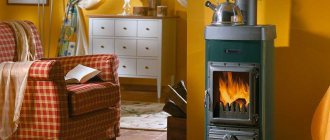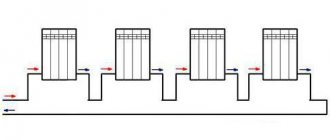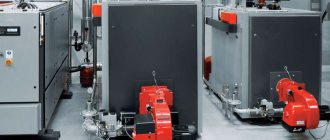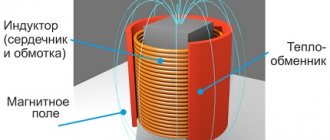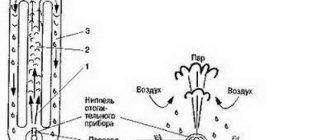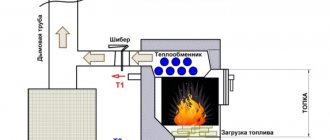The principle of operation of a diesel fuel boiler
In terms of their operating principle, these devices are no different from turbocharged gas mechanisms.
The algorithm for their work is as follows:
- The air, directed by an inflatable fan, is mixed with diesel fuel, which leads to the formation of a special mixture.
- This composition is sent to the boiler furnace, where ignition occurs caused by electronic ignition.
- During the combustion process, the thermal energy generated by solar oil is transferred to the heat exchanger and, as a result, to the coolant.
As can be seen from the operating principle described above, diesel boilers operate identically to gas-fired systems. Moreover, in order to convert a standard gas boiler into a device running on diesel fuel, it is enough to just replace the burner in the product.
In addition, the similarity of equipment such as a diesel boiler with traditional heating mechanisms is that they can also be easily controlled electronically.
So, by setting the thermostat to a certain mode, you can automatically adjust the speed at which the fan will rotate, the frequency of fuel supply, the ignition system, etc., thereby ensuring that a stable temperature is maintained in the living room. But there is still a slight difference between diesel fuel boilers and standard systems: the first samples are produced exclusively of the floor-standing type, while gas devices may have different installation options.
How to choose a boiler for heating a private house?
If you still choose a diesel unit, its purchase should be based on the following factors:
- Type of burner. The best option is a replaceable burner powered by a diesel or, if necessary, a gas source. If there is a burner heating system, fuel consumption will be significantly reduced.
- Boiler productivity. It is calculated taking into account the volume of the room and the amount of diesel fuel used. As a rule, 1 kWh of energy is consumed per 10 m². For housing with an area of 150 m², it is necessary to purchase a boiler with a capacity of at least 15 kW, and preferably a little more, so that there is a reserve of power for extreme cold.
- Number of circuits. You need to decide how the water will be heated. Boilers are produced with already built-in boilers, or, for example, with a second circuit for an indirect water heater purchased separately.
- Firebox material. The steel body of the firebox is more economical, but not as wear-resistant and durable. The cast iron firebox is designed for 50 years of operation and is resistant to sulfur-containing condensate and corrosion. At the same time, it is susceptible to cracking due to temperature changes.
- Type of fuel material. The best option, of course, is to work on all types of fuel (diesel, waste oil, gas). But this option will be a very expensive purchase.
Advantages of diesel heaters
Speaking about the advantages that diesel heating boilers have, attention should be focused on the following:
- the ability to control the operation of the system at a distance, that is, without direct intervention. This opportunity will greatly make life easier for those owners who are not used to systematically chopping wood and heating the boiler for a long time - thanks to the remote control, the boiler thermostat will independently cope with the fuel supply and ignition;
- Despite the fact that the operation of the gas mechanism is more economical, a diesel heating boiler can be installed in any area without fear of the lack of a gas supply point. In addition, to install it you will not need to obtain any permissions; you will only need to purchase the desired device;
- installation of gas equipment necessarily requires the help of a qualified specialist, who usually present a wide list of requirements not only for the device itself, but also for the area where it is installed, while a diesel fuel heating boiler can be installed with your own hands anywhere. If you wish, you can turn to specialists for help, but only to look at various photos of samples of these boilers and options for their location;
- A diesel fuel heater is more cost-effective than a device powered by electricity. Thus, the consumption of diesel fuel for heating a house is less, if we draw an analogy with electricity.
Disadvantages of diesel boilers
When choosing a heating system and boiler models, each buyer should be guided not only by the advantages of a particular installation, but also by the disadvantages, so as not to receive an unpleasant surprise during operation of the system.
- Installing a diesel system is quite an expensive task. In addition to purchasing equipment, it is necessary to purchase a container for storing fuel, purchase a significant amount of heating material at a time, and also allocate a separate room for this container.
- It is irrational (expensive) to heat a small room with diesel.
- Boilers require systematic cleaning, care and maintenance. After the combustion of the fuel, soot remains, which can clog the mechanism and interfere with the normal operation of the system.
- Automation of the heating unit occurs thanks to electricity. In the event of a power outage, this autonomous system will not be able to perform its functions.
Rice.
5 Combination boiler (no votes yet)
Rules for calculating fuel consumption
In order to correctly calculate all expenses and not waste most of the funds, it is recommended to consider the following rules:
- in a relatively warm region, it will be enough to install a device whose thermal energy is calculated according to the principle of 1 kW/10 m². This will be enough to ensure full heating of the room;
- Judging by calculations, one liter of solar oil can provide a residential building with ten kilowatt-hours of energy. Accordingly, in order to fully heat a house with an area of 100 m², it is necessary to burn one liter of fuel every hour;
- experts say that with the correct calculation of the operation, the device can function normally even at half its power, so not one, but half a liter of diesel fuel will be enough to provide good heating to the house.
Pros and cons of installing a diesel boiler room
Before choosing one of the heating systems, it is necessary to take into account all the positive and negative aspects associated with the use of this or that equipment. The advantages include:
- high level of efficiency of the device, which can reach up to 90%;
- the device can be easily converted to work with gas when replacing the burner;
- a wide range of budget options;
- the necessary source of electricity is required only to ensure the operation of automation systems;
- availability of diesel fuel;
- safe to use.
The disadvantages of using diesel heating boilers include:
- the cost of liquid fuel is quite high;
- for long and uninterrupted operation of the equipment, you need to use only high-quality diesel that meets all the standards and requirements for the specific model of the unit;
- despite the presence of automation, the boiler requires the constant presence of people;
- the house must have good ventilation, as the smell of diesel fuel will spread throughout it;
- needs to equip a separate room - a diesel boiler room.
Tip: In order to protect the structure, place the container with diesel fuel in the ground outside the room.
Alternative heating boiler options
It happens that there is no gas supply line near a residential building, and using electrical equipment is too expensive. In this case, it is necessary to find a boiler sample that, firstly, will have low financial costs, secondly, will work autonomously if possible, and thirdly, will not require significant installation costs. These requirements are met by devices that are very popular in the construction market today - boilers operating on the top combustion principle, as well as heat pumps.
Main stages of work
Installation of a diesel boiler has its own characteristics. It is more difficult than gas or electric equipment, and is also more expensive. But if none of the other types of fuel is possible, it has to be made.
The main difficulties when installing diesel boilers arise from the storage equipment for the energy carrier, as well as from the work on supplying it to the burner.
So, the connection structure and installation of diesel heating boilers consists of the following steps:
- Selecting a location and preparing a foundation for the apparatus, usually it is made of concrete or in the form of a metal frame;
- Installation of a diesel boiler with its leveling;
- Installation of supply and return pipes (with installation of a dirt filter on the return pipe, which protects the equipment from foreign particles entering it);
- When choosing a 2-circuit device, it is necessary to make a DHW connection;
- Installation of a fuel tank, with laying of a pump and pipe to the device for supplying energy;
- Carrying out work on connecting the chimney;
- Launching the system and testing its correct operation in different modes.
It is important to remember that each of the listed stages must be completed taking into account all requirements. For example, certain conditions apply to the rooms in which the boiler will be installed. They relate to ceiling heights, area and the presence of emergency exits:
So, a device with a power of up to 60 kW can be installed in the kitchen, although not everyone wants this. For stronger units, you need to choose rooms with a height of at least 2.5 meters and a volume of more than 15 m³. At the same time, they must have ventilation and good lighting, and surface finishing is permissible only with materials with fire-resistant properties.
If your boiler room is located on the ground floor, then you need to organize an additional fire exit. But for diesel appliances with a power of more than 350 kW, it will be necessary to build a separate room at a distance of at least 1 m from window and door openings.
According to fire safety regulations, fuel must be buried in the ground. This will save diesel fuel from low temperatures, which negatively affect the viscosity of the fuel. Viscous fuel puts a strain on pumping and significantly increases the consumption of energy resources.
And further! Surface storage requires a container protected from sunlight. The ideal option is a stainless steel storage unit. To heat the entire house, you need to buy a container with a 4-10 ton volume.
As you can see, installing equipment does imply additional financial costs for creating storage. This is the most difficult stage of installation, which determines the further safety of use.
Having decided on the room and installing all the necessary equipment in it, they begin to connect or tie up the boiler. This point must be approached very seriously, since the operation of the entire system as a whole will depend on it. In order for everything to be connected correctly, you need to create or find a wiring diagram on the network. It can be different, depending on the power of the device, the properties of the boiler room and the installation of protection.
If you have the necessary skills, you can install diesel heating boilers yourself. But since in the future you will still have to contact special companies for warranty maintenance, it is better if they carry out the installation. This will make it possible to receive a future guarantee for the high-quality operation of the boiler and free service.
Features of the top combustion boiler system
The production of these mechanisms began quite a long time ago, and the very scheme of their operation is extremely simple and consists of the following: the boiler furnace should be filled with fuel (coal, firewood), and then set it on fire only from above. In this case, only the top layer will burn, where, among other things, the air necessary for combustion must also be supplied.
The combustion area is separated from the upper chamber, where the remaining combustion products are burned, by means of a large metal disk, and the ash formed during operation simply disappears thanks to the hot gases in the furnace.
Characteristics of heat pumps
Such systems have also become widespread not so long ago.
If we talk about their design in simple terms, then their design is very similar to a refrigerator that works in the opposite direction. This means that heat energy is pumped from a cold or low-potential source to the desired object. There are three main types of cold heat sources:
- Geothermal type pumps (for more details: “Geothermal heating: principles of operation with examples”), which cost quite a lot, but are capable of providing high-quality heat to any room (for more details: “Geothermal heat pumps for heating: principle of system design”).
- Pumps operating on water. If there is a reservoir nearby, you can get unlimited access to free heat (pro
